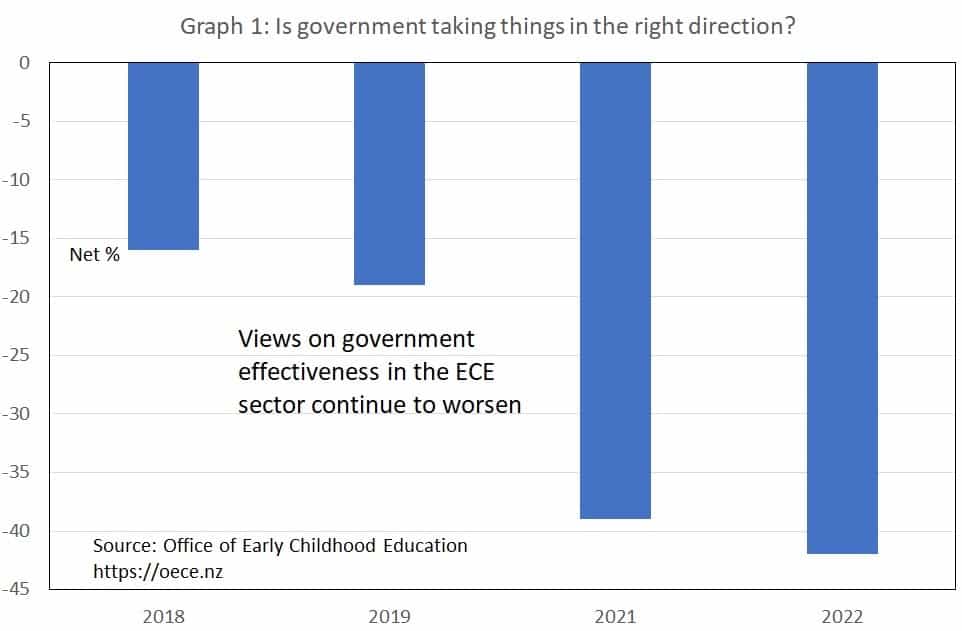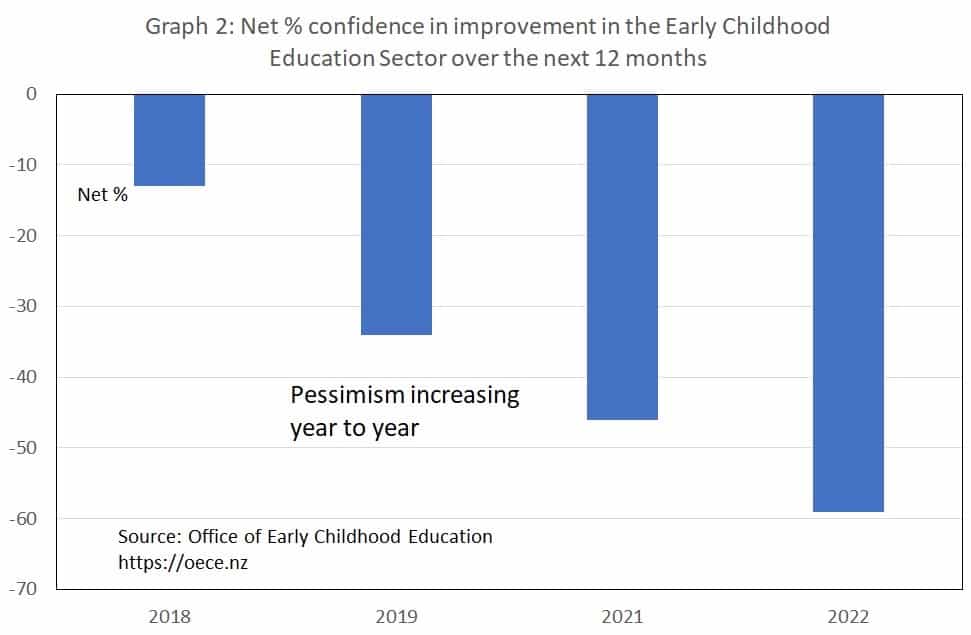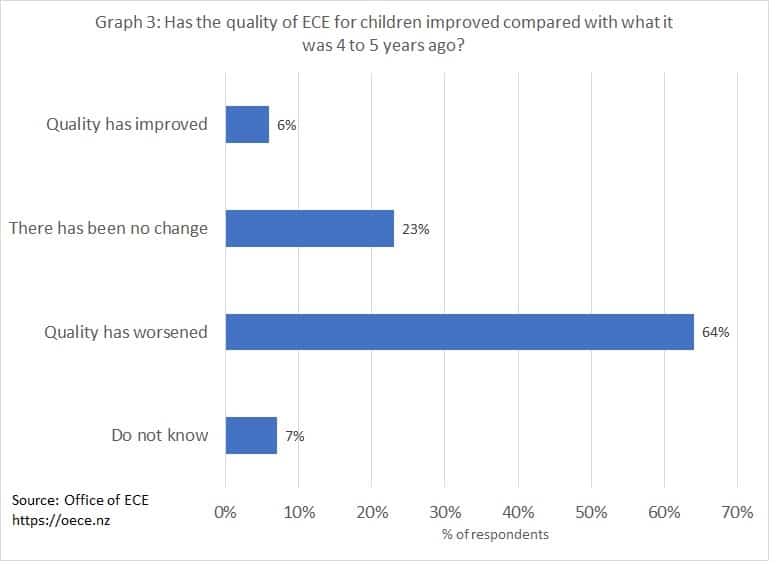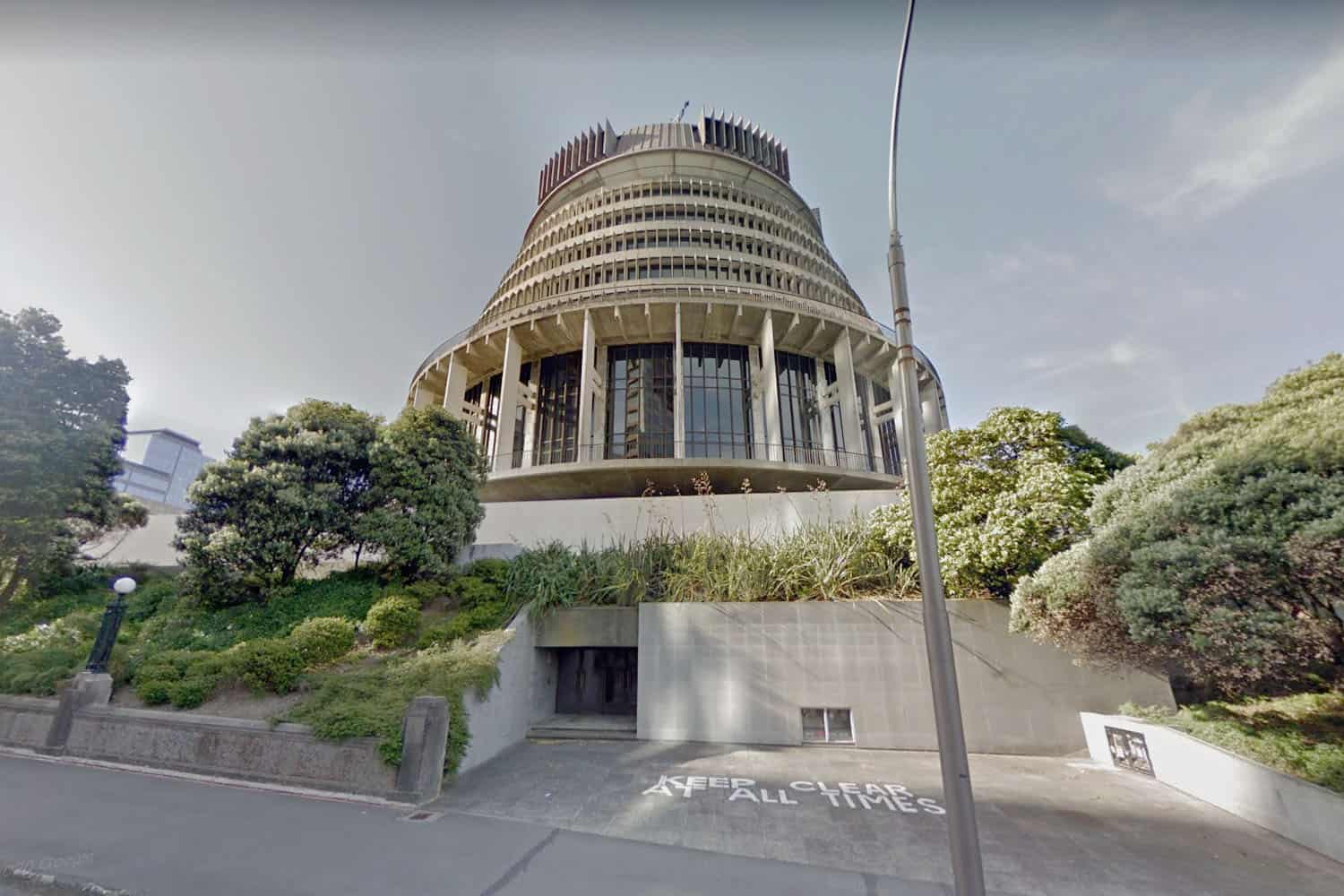Each year, in the weeks leading up to the Government’s annual budget, the Office of Early Childhood Education (OECE) surveys confidence in the early childhood education (ECE) sector. The results provide a gauge of the state of the sector and any changes in outlook.
The Government has expressed many policy aspirations for improving outcomes in the ECE sector, however feedback from this 2022 coalface survey tells us that the sector is in crisis and changes are necessary.
The Confidence Survey
In April 2022, 1,000 members of the ECE sector were surveyed. They were asked four questions.
- Did they think the Government was taking things in the right direction?
- Did they expect things to improve, worsen, or stay the same for the ECE sector over the next 12 months?
- Were they confident in Labour delivering on its promise of pay parity for ECE teachers before the next election?
- Had the quality of ECE improved for children compared to 4 or 5 years ago?
The fourth question was added to the survey this year specifically to gauge whether the quality of ECE for children has improved under Labour during their time in government. Hon. Minister Chris Hipkins has held responsibility for the Education portfolio (including ECE) since October 2017. The government is responsible for ensuring the Ministry of Education is adequately resourced to support and manage the early childhood sector. (See the Appendix of this report for an outline of the promises Labour made going into the 2017 general election and its 2020 core policy commitment to providing pay parity for all ECE teachers.)
Survey participants were from a broad cross-section of ECE service groups and connected parties:
- Non-kindergarten education and care centres including hospital-based (private 60%; community-run 16%; total 76% of respondents)
- Kindergarten Association services (10% of respondents)
- Home-based ECE (4% respondents)
- Playcentre, Kōhanga Reo, and Playgroups (3% of respondents)
- Other respondents (7%) – including teachers relieving across different services, initial teacher education providers, researchers and academics, policy advisors, professional development providers, teacher recruitment, ECE business broker, and retired ECE managers.
Is the Government taking things in the right direction for ECE?
The education sector is generally favourable towards the Labour Party. So, it could be expected that attitudes toward what the government is doing for ECE would be improving. But, in 2022, an increased proportion of respondents believe that ECE is being taken in the wrong direction by the government – 63 per cent compared with 55 per cent in 2021 (See Table 1).
TABLE 1: Respondents’ confidence in the government taking things in the right direction for ECE and comparison to previous years.
| Year | Right direction | Wrong direction | Neutral or can’t say | Net % right direction |
| 2018 | 26% | 42% | 32% | -16% |
| 2019 | 30% | 49% | 21% | -19% |
| 2021 | 16% | 55% | 29% | -39% |
| 2022 | 21% | 63% | 16% | -42% |
While there has been a slight improvement in the proportion of respondents who believe ECE is being taken in the right direction – 21 per cent compared with 16 per cent last year – this is more than offset by the increased proportion of those feeling things are going in the wrong direction. Balancing the two, there is an increase in the net proportion of respondents who think that ECE is being taken in the wrong direction. The increase is not significant between 2022 and 2021, but it does show that confidence has not returned following a sharp drop between 2018 and 2021.

Why is there such a belief that Government is taking things in the wrong direction? From the comments received in the confidence survey, there were four main themes.
- That the grace period for Labour in Government was believed to be over and it was time for it to prove itself. Respondents were not seeing results for promises made.
- “Minute steps, barely any progress.”
- “I think they are saying the right things however their actions are not measuring up to their words.”
- “Progress so slow that in fact we are heading backwards.”
- “Our sector is consistently treated like the poor cousins in education.”
- That the government was not making an effective difference in what it was doing, or what it had done was wrong or harmful.
- “So far the steps they have taken have not been effective.”
- “How can the government possibly think it’s okay to have a teacher responsible for supervising children and staff who is not trained in early child care?”
- “Getting teachers from overseas who do not know our curriculum is so hard on us.”
- “The workload is ridiculous with compliance and all the documentation. The new NELP is just added work.”
- “ECE is a train wreck. So much pressure from officials who make our job so bogged down by paperwork and compliance – which we have to pay for from an uneven tired undervalued workforce with the teachers of quality pulling the weight of many untrained staff behind them because it’s cheaper.”
- That the government was failing to act on what was important and/or urgent.
- “Conditions in the ECE sector and poor government stewardship has been ignored.”
- “They have no concept of the trouble the sector is in.”
- “Ratios are appalling, pay is still not right, workload and expectations from Ministry of Education are unrealistic, and no support with child behaviours and diverse needs.”
- “We rarely hear the government talk about quality care and ratios. Strategic objectives have been piecemeal and I am afraid we are heading towards a funding system that is more complicated than the current one.”
- “Overcrowding. Too many unqualified teachers employed. Skills and experience of older teachers have been lost.”
- “I am an ECE teacher and I have been for the last 12 years. I have never felt so spent and used like this before. I feel I am grossly underpaid and undervalued. I am at breaking point.”
- “Society views about ECE need to change which needs to be led by a government that understands, believes, and supports the importance of good ECE for our future generations. With all the pay and funding ‘issues’ too many wonderful teachers have been lost.”
- Perceived funding inequities and government and Ministry of Education bias toward large for-profit centre organisations.
- “Smaller services need URGENT financial assistance to survive.”
- “Small centres can’t afford the “pay parity” rates… how do they address this?”
- “I think the government is anti-small, privately-owned services.”
- “With the last budget being massively small our Playcentre was not able to stay open. This was even more upsetting when I saw other centres were given almost 30 times more than us! We are parents wanting to be with our children and be their first teachers. Please rethink the amount we get so we can spend more time enjoying our children and less time doing unnecessary paperwork.”
- “The regulations will be watered down to keep business in business.”
- “The Ministry’s too concerned with supporting the corporates, fund-mangers, and shareholders to keep their costs down and profits up and not what’s good for children.”
What is the outlook for the ECE sector in the next 12 months?
The 2021 survey suggested a new wave of despondency as the sector had become more pessimistic about the outlook for ECE. This year’s survey results show that despondency has set in.
In 2018, 23 per cent were confident there would be an improvement but this has dropped away to just 4 per cent this year (see Table 2).
TABLE 2: Respondents’ confidence in improvement in the ECE sector over the next 12 months and comparison to previous years
| Year | Improve | Worsen | Stay the same | Net % improve |
| 2018 | 23% | 36% | 41% | -13% |
| 2019 | 12% | 46 % | 42% | -34% |
| 2021 | 8% | 54% | 38% | -46% |
| 2022 | 4% | 63% | 33% | -59% |
Back in 2018 at the time of Labour’s first Budget after it was newly elected in, a net 13 per cent of respondents had a negative outlook, and it has got worse ever since

Without doubt, Covid-19 has impacted everyone’s lives and livelihood in some way. But the proportion of those who did not think there would be an improvement in the ECE sector had begun to drop before Covid-19 started to have an impact.
Key themes in the comments were:
- Broken promises
- “ECE is always forgotten, promises are made but then not delivered. This government promised to work for ECE and that is why I voted for them. It hasn’t happened. They blame COVID but it was already a problem before COVID.”
- Government ignoring the sector and the reality of what was happening on the ground
- “Losing hope that this government will listen to anything apart from their own spin.”
- Services’ financial operation difficulties
- “Each year this Government has made things worse for ECE and now with inflation and the cost of living has increased, we are unable to ask parents to help with the increase in costs as they are already struggling.
- “No quick fix here it starts with government taking back the sell-out of our early education system to profiteering corporations that have no understanding about child development.”
- “Corporates and other services with minimum staffing ratios and centres staff with more new graduates. Yet services with good ratios and loyal long-term staff are being pushed to the wall.”
- “Small centres are being squeezed out by the big companies as they cannot compete with fees etc. So much for quality care!”
- Falling standards and no support for improving quality
- “Minimum standards are becoming the norm.”
- “Until the government and ministry act against ‘bad’ employers and service provider regulation breakers, nothing can improve.”
- “Most owners of centres are dropping to the minimum staffing ratios to save money.”
- The failure of current policy measures to address staffing issues
- “Getting in foreign teachers and primary school teachers is a band-aid. This is just making the problem worse.”
- “It’s HARD to get qualified teachers and most of them are doing it to get their residency, once they have got the visa they resign. ECE is experiencing very bad situations.”
- “More teachers are going to burn out quicker.”
- “Hearing and seeing so many centre managers and their teachers are overworked. I don’t see this changing.”
- “Everyone wants to leave. I am now seeing students that don’t even want to finish their degrees because they can already see how hard it is going to be for them to be a teacher with all that is expected of them.”
- “I can’t see why you would want to work in home-based and become a visiting teacher now when you can earn the same amount in a non-stress role that leaves work at work and needs no responsibility.”
- “Unless historical underfunding of Playcentre is addressed and set to rights, I do not see how things can improve. Our organisation is trying to squeeze too much work into too few hours out of too few employees.”
Confidence in the Minister of Education to deliver pay parity
An increased proportion of respondents this year do not have confidence in the Minster of Education to deliver pay parity. Last year 64 per cent expressed a lack of confidence, this year it is 79.5 per cent.
This is surprising because as a press release from the Minister of Education’s Office read: “Pay parity conditions and higher funding rates for education and care services will come into force on 1 January, 2022, Minister of Education Chris Hipkins confirmed today”. But, an analysis of respondents’ comments reveals that this is not true. Respondents said that trust had been broken and the Minister’s words ring hollow:
- “No faith as they’ve not kept their word so far. Budget headlines vs reality – big disconnect.”
- “The watering down of the pay steps and not full funding last time makes me not trust them at all, as they were so excited to announce it, yet so far away from their promises.”
- “I believe they have no interest in the babysitters – they still can’t call us early childhood teachers. The term daycare is still prominent from their mouth.” (daycare is what Minister Hipkins calls his child’s ECE).
- “Labour put out in May last year to the media they were doing pay parity and that turned out not to be true. Our centre cannot afford to opt-in. At our centre, if my sign said “Kindergarten” and not “Childcare” we would get $54,000.00 more in funding. That is enough to pay for an extra teacher or at least pay the ones already employed what they are worth.”
- “The kindergarten collective agreement is up for negotiation again soon which will inevitably widen the gap further between kindergarten and other ECE.”
Respondents reported major issues with how ‘pay parity’ was being implemented and felt that the Ministry of Education was gatekeeping and delaying all but some beginning teachers from receiving pay parity.
- “Why can’t we be funded like the Kindergarten Associations? Happy to sign on a dotted line so to speak. I want Pay Parity for my staff but can’t afford to do so… keep coming up short of $$$”
- “The opt-in for 5 steps of pay parity has caused further division between services in the ECE sector – it should be compulsory for all.”
- “Centres can claim the funding and attest to paying their staff up to pay Step 5 but getting centres to pay individual staff at the correct level for them is a challenge.”
- “I won’t benefit from it. Apart from working part-time meaning I won’t generate enough hours to ever climb the parity ladder for years my manager has said pay parity will now mean we must cover the costs of teacher registration, first-aid training, etc, leaving me paying more and earning less (my manager says this is the new standard in the sector).”
- “It doesn’t look like it is coming for those of us with many years of experience and in positions of responsibility.”
- “The survey that the Ministry of Education is doing currently to better inform government of costs of centres is ridiculous. The government already knows what it costs to run a centre based on what they pay kindergartens. Besides, to ask for expenses to be split by certificated teachers’ wages and then everything else tells them nothing, what about rent/mortgage payments, insurance, rates etc some of these are massive costs.”
- “Despite knowing (and saying) that a new funding system is needed in order to deliver pay parity, the Ministry of Education did nothing about developing one for more than a year after the Minister made that announcement.”
Of those who believe Labour will follow through on its promise of pay parity (20.5 per cent of respondents), some were sure of this only because they felt it was a ploy for support.
- “They need teacher support to get in again for another term.”
- “It will happen because the election is coming up.”
While others expressed wavering confidence.
- “I am hopeful but I am not holding my breath.”
- “Yes, although there will continue to be a huge push back from the Early Childhood Council and owners.”
- “Yes, but I wouldn’t be surprised if the goalposts kept being moved, as they have already.”
What’s happening to the quality of ECE for children?
The quality of ECE is perceived by most respondents to have worsened for children over the past four to five years.
- “NZ was once a leader in ECE. We should be ashamed of the care now being offered to our children.”
- “It is more widely accepted by employers that things are bad but that is just how it is so teachers are expected to just deal with it.”
- “Over the last 20 years – some big improvements and proud of the sector. In the last few years, that’s changed. Teacher shortages, increasing paperwork and distractions, funding not covering inflation, pay parity not being delivered.”
- “It has become child farming not child care.”
Graph 3 shows that only 6 per cent of respondents believed quality in the sector had improved. These respondents offered few comments as to why they thought this. One commented that they were not in favour of pay parity but that any increase in funding was a good thing. Two respondents commented that they approved of steps being taken to tighten compliance for services not meeting regulations and some commented about teacher relationships with children as being better and teachers had learnt more about what is good for children.
Sixty-four per cent of respondents said the quality of ECE had worsened and a further 23 per cent believed ECE quality had not changed. Seven per cent of respondents were not sure or had not been in the sector long enough to know.

The main themes from an analysis of respondents’ comments on why there had been no improvement in ECE quality were as follows.
- Child numbers and adequate numbers of adults for the number of children and the work to be performed
- “It’s far worse. It’s 100% downhill. Our ratios and numbers in centres used to be so much better and we had an abundance of teachers – there was joy in ECE.”
- “Kindergartens are running rolls at over ratio numbers for funding and opening all year.”
- “Tbh you’d have to go back a long way before it was better though. Big point: increasing max centre licences to 150 children was the worst government decision.”
- “In kindergartens we take two-year olds now. So we have nappies to change and just 4 teachers to 40 children. We have so many more children that are additional needs which puts immense stress and pressure on the 4 teachers. Things become very unsafe when we are changing nappies have 40 kids and 4 of them for example have additional needs, they might only get 1.5/2 hrs support a day if they are lucky and the rest of the time we are left to manage these children on our own.. it’s not about being exclusive but the safety of children is seriously compromised and the regular children are missing out on quality interaction and experiences.”
- “Because we are too focused on paperwork and all the documents we have to checklist we have forgotten that actually being with children and teaching them is most important.”
- “If all ECE services had teachers who were there to support, love, teach the children without being overwhelmed by paperwork imagine the amazing children entering school and society. We get one shot at getting it right with young children and we are mucking it up at every turn.”
- Continuity of care for children has become a major issue due to staff retention issues
- “Quality has worsened as evidenced by the departure of teachers from early childhood to primary teaching or leaving teaching altogether.”
- “I remember working at centres that had the same teachers for years, never relievers unless necessary, the quality of relationships and care and education for children was much higher because of this.”
- “It wasn’t great then, but it is definitely worse now with teacher retention bad.”
- Children more likely to be seen as dollar signs
- “Definitely worsened… children are just bums on seats and money to the owners of centres.”
- “Centres competing for enrolments and discounting fees. I feel like it is a race to the bottom.”
- “Worse it’s all about numbers through the door now.”
- “There are more corporate-owned centres that are finance driven. They are buying out the smaller centres who can’t compete. The new regulations are allowing for large numbers of tamariki in huge centres where quality care and learning is lost due to numbers”
- “Our centre is doing well as we are community based. However, I feel the sector in general has decayed due to corps being allowed to buy up centres to make a profit on children. It needs to change.”
- “Too much privatisation – people profiting off vulnerable children with no care for these children. Money is everything.”
- “Private ownership has not improved this sector especially when it’s run for profit. I’ve been there. It got to the stage where we were ready to bring our own toilet paper and food for the kids. Would I want my kids or grandies being raised in a centre today – no. Too many kids. No home-like feel. High stress for children and teachers – long hours.”
- “More centres are being built by those whose only interest is profit and keeping the parents happy at the cost of important play-based learning. Limited time outdoors, no challenge playgrounds. Mat times where children are lectured about rules. Older children forced to lie on carpet or sit on mats while teachers take lunch breaks.”
- The quality of teaching staff
- “Many centres taking on more unqualified staff with no training in child development.”
- “We used to have more NZ born teachers and teachers that were trained just in ECE only.”
- “Teachers leaving due to low wages – so instead of fixing the wages government decided to import teachers from other countries.”
- “Encouraging primary trained teachers and overseas teachers into the sector, all who have no basis or understanding of Te Whāriki and the overseas teachers no understanding or knowledge on Te Tiriti o Waitangi. These are problems that are just the very tip of the iceberg.”
- “The quality of ECE teacher training is poor. Worse for graduate diplomas.”
- “Unsatisfactory providers of Education training such as (name withheld). Resulting in substandard teachers being qualified.”
Some respondents also questioned the effectiveness of the Ministry of Education when it comes to overseeing ECE services and their management.
It is evident from respondents’ comments that many of the promises Labour made for improvements in ECE (see Appendix), such as improvement of regulation for 80% ECE qualified teachers, smaller group sizes and better ratios, are yet to be followed through while it is in Government.
The effect of not addressing problems in the quality of ECE is cumulative and it would appear from the results of this survey that the rot has started to set in.
Conclusion
In general, the survey results show desperately low confidence throughout the sector. While there is no doubt some individual ECE services are thriving and there are pockets of excellent management and care throughout ECE, sector issues such as pay and recruiting and retaining trained teachers appear to be having an on-going and increasingly negative impact.
The survey also highlights a lack of confidence in those who oversee the sector, both in the Ministry of Education and in the Government and a feeling that nothing has been done to effectively improve conditions in the sector.
For the results to be reversed next year, serious work needs to be done by the Government to implement pay parity properly, follow through on promises to improve the quality and standards of ECE, and address where the management of the sector by the Ministry of Education can be improved.
It is also important to share this information with the public. When parents are aware of what is happening, they can think about how this could impact the standard of safety education and care provided to children, fees, and other important aspects and help to advocate for necessary change.
APPENDIX – Labour policy commitments for ECE
At the time of the 2017 General Election Labour promised to:
- Require centres to employ at least 80 per cent ECE qualified teachers by the end of the first term in government.
- Improve group size in centres.
- Improve teacher:child ratios for infants and toddlers
- Put the “free” back into the policy of 20 hours free ECE.
- Actively support establishing new public early childhood centres in areas of low-provision through targeted establishment grants. And, only provide taxpayer subsidies for new centres if there is an established need in the proposed location.
- Boost support for parent-led early childhood services such as Playcentre and Kohanga Reo, including funding to increase participation.
- Support and lift the quality of ECE service provision, with a focus initially on providers who predominantly enrol Pacific children.
- Investigate creating a smoother pathway from parent teacher qualifications (e.g., Playcentre qualifications) to initial teacher education programmes.
- Develop a network of high-quality centre-based early intervention programmes addressing the needs of vulnerable children in the most deprived areas
- Progressively increase the level of funding provided for early intervention in ECE to better support those with identified additional needs
- Ensure a dedicated professional development programme is developed and implemented for ECE staff who predominantly serve Pacific kids.
- Undertake a review of home-based, including investigating the introduction of minimum qualification levels for all home-based educators.
- Develop a second version of Nga Huarahi Arataki – Pathways to the Future, a 10-year strategic plan for early childhood education.
To date (as at April 2022), the 2017 election promises Labour has carried through whilst in government are numbers 12 and 13 above. If it has delivered in any part on other promises, positive effects are not being felt from within the ECE sector.
At the 2020 general election Labour promised it would deliver pay parity to all ECE teachers:
One of the core commitments that the Labour Party is making in our next term of government is extending pay parity to all teachers working in early childhood education, making sure that they are all paid what they are worth, and at the moment they’re not and that’s got to be fixed.
Minister Hipkins’ statement made during a TVNZ interview, September 15, 2020.

However, pay parity has not yet been provided to all teachers working in ECE. In May 2021 Minister Hipkins announced that Budget 2021 provided funding for teachers employed in education and care centres only to be paid at the bottom six steps of the eleven-step base pay scale for teachers. He said that the scheme was optional for employers and not be applied to all teacher-led education and care centres that were not kindergartens. He then announced a change in the Budget commitment, reducing the number of pay steps from the bottom 6 to the bottom 5. The policy took effect from 1 January 2022.
As of the 1 March 2022, 79% of all non-kindergarten teacher-led centres had opted-in. Those that did not opt-in were predominantly smaller centres – community-owned and owner-operator centres – which suggests that the scheme is better suited to large and commercial operations with economies of scale. (Get the full details in an article on centres that have opted into ‘pay parity’ rates)








